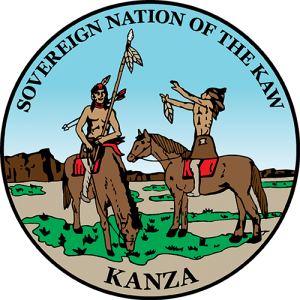Cultural erosion and revival
After removal from Kansas, much of the tribe’s traditional ways and culture diminished in a short time. The government mandated tribal children to go to school, yet they were not allowed to speak their tribal language and were punished for doing so.
In June 1898, Charles Curtis sponsored a bill in Congress which upon passage came to be known as the Curtis Act. The reservation was broken into individual Indian allotments, and Congressman Curtis (one-eighth Kaw) and his three children received 1,625 acres (Unrau, 1991).
In the mid-1880s, three members of the Kaw tribe visited the people of the Waxáxonlin (Pawhuska) division of the Osage, to offer them a ceremonial drum, symbolizing cultural interexchange and aimed at heritage preservation.
The Kanza called their dance I’Loshka Wachín. Little Jim, Barkley Delano and Jim Pepper, all prominent young men in the Kaw Tribe, stayed at the home of Mozhon Okashe (Mashunkashey), near modern day Pawhuska, Okla. They remained among the Osage throughout the winter to discuss what form and structure the new dance would take among the Osage. Mozhon Okashe assumed a great responsibility when he and his family accepted the drum to be used in the dance in the name of his young son, Ben Mashunkashey, the first Pawhuska Drum Keeper. The first I-Lo-Skah (Inlón-shka), the Osage name for the dance, was held soon afterward under the leadership of Mashunkashey (Swan).
The 1984 I-Lo-Skah ceremony was selected to observe the Centennial by elders of the Pawhuska District.
Two public programs were held to allow local individuals the opportunity to present information and personal observations on the history and meaning of the I-Lo-Skah in the Pawhuska district. The first program was held on the morning of June 21, 1984, for the purpose of unveiling the commemorative plaque. The second public program was held on June 23, 1984, in the dance arbor at Pawhuska. At that time many Kaw tribal members attended the ceremony. M.M. Chouteau was Chairman of the Kaw Nation at that time. Newman Littlewalker, Vice-Chairman then, spoke about the history of the Kanza people and the circumstances involved with the passing of the Kanza’s tradition and custom to the Osage.
A plaque was unveiled which read, “100 years I-Lo-Skah Centennial, 1884-1984. Commemorating the hundredth anniversary of the acceptance of the I-Lo-Skah from the Kaw Indian Tribe to the Osage Indian Tribe, Pawhuska District. 1884 Drum Keeper: Ben Mashunkashey. 1984 Drum Keeper: Samuel Lookout.” Pictured on the plaque is a straight dancer standing by a drum.
Desiring to revive the Kaw’s dancing tradition, Maudie McCauley Rowe decided in the fall of 1977 to hold a dance in her son Elmer Clark’s backyard in Shidler, Okla. He honored Mrs. Rowe’s request by helping her with the dance. It was the first Kaw dance in many years, and several of the last full-bloods attended. As a result of her actions, these days the annual Kaw Powwow is held the first weekend of August each year.
The Kaw began dancing the I’Loshka Wachín in early 2000. Elmer Clark blessed a new drum and appointed a new drum keeper.
Modern times
Kaw Nation Business Services (KNBS) activities include several businesses located throughout Kay County. To learn more, please visit http://www.kawenterprises.com/.
The Kaw Nation Headquarters also oversees the Kaw Housing Project, Kanza Health Clinic, Kanza Wellness Center, Kaw Nation Police Department, Kaw Nation Emergency Management, Kaw Nation Judicial Branch, Kaw Nation Environmental Department, Kanza Language Department, Kanza Museum, Kanza News, Kaw Nation School Age Enrichment Center, Child Support Services, Social Services and Academic Scholarships, Library and Learning Center, Title VI Lunch Program, and is a member of the Chilocco Development Authority.
Primary source
William E. Unrau, “The Kaw People” and “The Kansa Indians”
